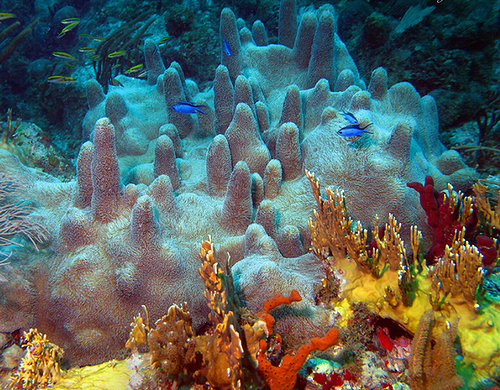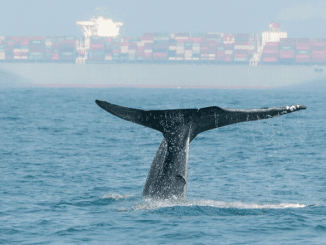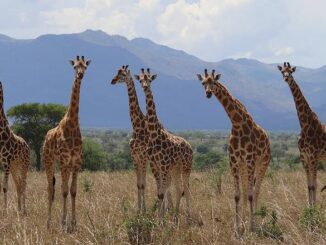
MONTREAL, Quebec, Canada, December 9, 2022 (ENS) – Today’s update to the IUCN Red List of Threatened Species exposes the many threats wiping out marine species – illegal and unsustainable fishing, pollution, climate change and disease. Populations of dugongs, vegetarian marine mammals related to manatees, and 44 percent of all abalone shellfish species enter the IUCN Red List as threatened with extinction. The pillar coral has deteriorated to Critically Endangered status.
Since the International Union for the Conservation of Nature founded the IUCN Red List of Threatened Species in 1964, it has become the world’s most extensive inventory of the global conservation status of species. The IUCN Red List now includes 150,388 species, of which 42,108 are threatened with extinction.
Over 1,550 of the 17,903 marine animals and plants assessed are at risk of extinction, with climate change impacting at least 41 percent of threatened marine species.
“Today’s IUCN Red List update reveals a perfect storm of unsustainable human activity decimating marine life around the globe. As the world looks to the ongoing UN biodiversity conference to set the course for nature recovery, we simply cannot afford to fail,” IUCN Director General Dr. Bruno Oberle said. “We urgently need to address the linked climate and biodiversity crises, with profound changes to our economic systems, or we risk losing the crucial benefits the oceans provide us with.”
This latest update to the IUCN Red List was released as 196 governments and many civil society groups are meeting in Montreal to strike a framework agreement that will guide global actions to restore and protect biodiversity for the next 10 years. The new framework to be agreed at COP-15 aims to halt biodiversity loss by 2030, and achieve recovery by 2050.
On December 6, COP15, the 15th meeting of the Conference of the Parties to the United Nations Convention on Biological Diversity was opened by Canadian Prime Minister Justin Trudeau, who highlighted Canada’s commitment to a successful COP15. The meeting is expected to produce an ambitious Post-2020 Global Biodiversity Framework by the closing date, December 17.
Prime Minister Trudeau announced that Canada will provide a new contribution of C$350 million to support developing countries, which host the vast majority of the world’s biodiversity, to advance conservation efforts. This is in addition to the more than C$1 billion Canada already has pledged to support climate action projects that address the effects of climate change on biodiversity loss in developing countries.
It is funding that has delegates to COP15 worried. They can agree on conservation measures, but if financing does not cover their plans, not much will happen.
IUCN Red List Update Puts Focus on Oceans
The first global Red List assessment of abalone, large marine snails, molluscs, that live in shallow coastal waters, has found that 20 of the world’s 54 abalone species are now threatened with extinction.
“Abalones reflect humanity’s disastrous guardianship of our oceans in microcosm: overfishing, pollution, disease, habitat loss, algal blooms, warming and acidification, to name but a few threats. They really are the canary in the coalmine,” said Dr. Howard Peters, member of the IUCN SSC Mollusc Specialist Group and research associate at the University of York, UK, who led the abalone assessment.
“The most immediate action people can take is to eat only farmed or sustainably sourced abalones. Enforcing fishery quotas and anti-poaching measures is also critical,” Dr. Peters said. “However, we need to halt the changes to ocean chemistry and temperature to preserve marine life including abalone species over the long term.”

Abalone species are sold as some of the world’s most expensive seafood. Unsustainable extraction and poaching are the primary threats to abalone, compounded by climate change, disease and pollution.
In South Africa, poaching by criminal networks, many connected to the international drugs trade, have devastated populations of the Endangered perlemoen abalone (Haliotis midae).
The first abalone assessment found that, “Increasingly frequent and severe marine heatwaves have caused mass mortalities, killing 99 percent of Roe’s abalones (H. roei) in its most northerly reaches of Western Australia in 2011.”
Marine heatwaves have intensified abalone diseases worldwide, affecting the Critically Endangered black abalone (H. cracherodii) in California and Mexico, and the Vulnerable green ormer (H. tuberculata), found from the English Channel to Northwest Africa and the Mediterranean, the IUCN said.
Marine heatwaves also kill the algae that abalones depend on for food.
Pollution from agricultural and industrial run-off cause harmful algal blooms, which have eliminated the Endangered Omani abalone (H. mariae), a commercial species found in the Arabian Peninsula, across half of its range.
Toxins such as antifouling boat paint further deplete abalone populations.
Dugongs Now Critically Endangered
Dugong populations in East Africa and New Caledonia have entered the IUCN Red List as Critically Endangered and Endangered respectively. There are now fewer than 250 mature individuals in East Africa and under 900 dugongs in New Caledonia.
The primary threats are unintentional capture in fishing gear in East Africa, poaching in New Caledonia, and boat injuries in both locations.
In East Africa, oil and gas exploration and production, bottom trawling, chemical pollution and unauthorized coastal development are damaging and destroying the seagrasses that dugongs depend on for food.
The degradation and loss of seagrasses in New Caledonia is the result of agricultural run-off, pollution from nickel mining and coastal development, and damage from boat anchors. The impacts of climate change present a threat throughout the dugongs’ wide range.
“Strengthening community-led fisheries governance and expanding work opportunities beyond fishing are key in East Africa, where marine ecosystems are fundamental to people’s food security and livelihoods,” said Evan Trotzuk, who led the East Africa Red List assessment.
“Further, the creation of additional conserved areas in areas where dugongs live, particularly around Bazaruto Archipelago National Park, would also empower local communities and other stakeholders to find, implement, and benefit from solutions that halt long-term declines in dugong abundance, as well as in seagrass extent and quality,” said Trotzuk, who serves as research and monitoring coordinator at African Parks Network.
“Earlier this year, we published a study that found the Chinese dugong population is functionally extinct; now two more dugong populations are one step closer to disappearing forever,” said Professor Samuel Turvey, Zoological Society of London. “From habitat pollution to warming oceans, ongoing human impacts continue to prevent marine ecosystem recovery, threatening the future of both these iconic animals and the many other species they live alongside. We need urgent action to fight climate change and biodiversity loss, as these two crises simultaneously threaten life on earth as we know it.”
At the University of British Columbia’s Institute for the Oceans and Fisheries, Professor Amanda Vincent, who chairs the IUCN Species Survival Commission’s Marine Conservation Committee, warns that “urgent action” is needed to save marine species.
“The awful status of these species should shock us and engage us for urgent action. These magical marine species are treasured wildlife, from the wonderful abalone to the charismatic dugong and the glorious pillar coral, and we should safeguard them accordingly. It is vital that we manage fisheries properly, constrain climate change and reverse habitat degradation,” Vincent said.
A self-proclaimed “ocean optimist,” Vincent directs Project Seahorse. She was the first person to study seahorses underwater, the first to document the extensive trade in these fishes and the first to initiate a seahorse conservation project. In 2021, she became the first marine conservation to win the world’s top animal conservation prize, the US$250,000 Indianapolis Prize.
Dr. Thomas Lacher, Jr. at Texas A&M University is not so optimistic.”Several dugong populations are now listed as Endangered or Critically Endangered. The dugong is the largest surviving species of Sirenians, an ancient order of mammals that possess unique adaptations and a deep evolutionary history. It is critical to provide protection to the dugong to avoid the fate of the Steller’s sea cow, which was discovered in 1741 and extinct within 27 years.”
“We know that human activities can impact these species negatively and quickly, thus the urgency of providing immediate conservation action,” Dr. Lacher said.
Disease Attacks Pillar Coral
The pillar coral (Dendrogyra cylindrus), found throughout the Caribbean from the Yucatan Peninsula and Florida to Trinidad and Tobago, has moved from Vulnerable to Critically Endangered on the IUCN Red List, after its population shrank by over 80 percent across most of its range since 1990.
The most urgent threat to pillar coral is Stony Coral Tissue Loss Disease, which has emerged in the past four years and is highly contagious, infecting between 90 and 100 metres of reef a day.
Bleaching caused by increased sea surface temperatures and excess antibiotics, fertilizers and sewage running into the sea have weakened corals and made them more susceptible to disease. Overfishing around coral reefs has depleted the number of grazing fish, allowing algae to dominate and putting further pressure on corals.

“The pillar coral is just one of the 26 corals now listed as Critically Endangered in the Atlantic Ocean, where almost half of all corals are now at elevated risk of extinction due to climate change and other impacts,” said Dr. Beth Polidoro, associate professor at Arizona State University and Red List coordinator for the IUCN SSC Coral Specialist Group. “These alarming results emphasize the urgency of global cooperation and action to address climate change impacts on ocean ecosystems.”
In time for COP15, new research from the University of Miami Rosenstiel School of Marine, Earth and Atmospheric Science shows that 70 percent of coral reefs off the coast of Florida are eroding and experiencing a net loss of habitat.
The Florida Reef Tract is the only living coral barrier reef in the continental United States and is one of the largest in the world. The decline is attributable to bleaching events, ship groundings and disease.
In 2014, the researchers discovered an outbreak of Stony Coral Tissue Loss Disease, which is killing reefs both in Florida and the Caribbean.
Florida’s coral reefs support around 70,000 jobs and generate US$8.5 billion annually, data from the National Oceanic and Atmospheric Administration show.
Despite the grim findings, researchers were able to identify certain regions that are more likely to persist in the future.
The COP15 on Biodiversity, happening through December 17 in Montreal, is enabling new partnerships and alliances to conserve what remains of the animal and plant species that still survive.
“Reversing these downward trends requires a holistic ecosystem approach, one that takes into account the critical benefits of protecting and restoring land – such as an island – to the marine environment around it,” said Re:wild Senior Director of Conservation Strategies Dr. Barney Long. “Re:wild, Island Conservation and Scripps Institution of Oceanography at the University of California San Diego launched the Island-Ocean Connection Challenge to restore at least 40 globally significant island ecosystems to benefit islands, oceans and communities by 2030. We call on others to join us.”
Featured image: Dugong mother and calf glide over sea grass along the coast of Timor leste, 400km north of Australia, at the eastern end of the Indonesian archipelago. (Photo courtesy Dive Timor)
© 2022, Environment News Service. All rights reserved. Content may be quoted only with proper attribution and a direct link to the original article. Full reproduction is prohibited.



